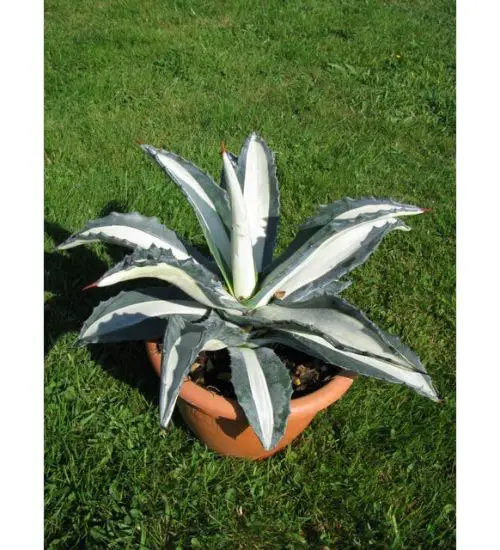Sun: full sun to partial shade
Water: Typical water needs for a succulent
Temperature: Zone 8a from 10° F to 15° F (-12.2 ° C to -9.4° C) to Zone 11b from 45° F to 50° F (7.2° C to 10° C)
Winter Survival: Cold hardy
Propagation: offsets
Flower:
Flower Type: Yellow
Toxic: Toxic to humans and animals
Dormant: winter
Space Requirement: Outdoors
Common Problems: pests
Where to buy Agave americana Mediopicta Alba?
Basc Care for Agave americana Mediopicta Alba
Watering
Watering for Agave americana Mediopicta Alba is a simple task. It requires Typical water needs for a succulent.
One simple tip for you is that you can use some online apps to check the soil status before you go water your succulents. I would recommend the ThePlantsCheck app, it has some nice features there.
Fertilizing
Only feed this succulent during its active growing seasons which means summer. Use the right fertilizer applied in the right amounts. Applying half-strength balanced fertilizer every month or so is recommended for optimal results.
Do not fertilize during winter as the plant is dormant.
Sun & Location Requirements for "Agave americana Mediopicta Alba"
Agave americana Mediopicta Alba does best when placed in an area that receives full sun to partial shade throughout the day. This variety of succulents can tolerate direct sunlight for short periods, but if the temperatures get too high or the light is too intense it may be beneficial to find a shadier spot.
As per this succulent profile, it is only able to stay healthy when the environment temperature is above the range of zone 8a from 10° F to 15° F (-12.2 ° C to -9.4° C).
Agave americana Mediopicta Alba is a member of the Agave family and is known for being cold hardy. It is able to survive temperatures down to 0°F, making it an ideal choice for areas with cold winters. The succulent's thick leaves and stems help retain moisture in its cells, allowing it to survive through frigid temperatures. Additionally, the colorful foliage of Agave americana Mediopicta Alba adds a festive touch to any garden in cold areas.
Agave americana Mediopicta Alba is an ideal choice for gardens in cold climates. Its thick leaves and stems help it retain moisture, and its colorful foliage adds brightness to any winter landscape. This succulent is renowned for being cold hardy and able to survive temperatures down to 0°F. With its ability to withstand frigid weather, Agave americana Mediopicta Alba is the perfect addition to any frosty winter garden.
Any succulents in the group will need a large space to grow. You should place your pot outdoor. Since this plant needs a lot of space than other succulents, you should consider not planting them together with other succulents/plants.
Agave americana Mediopicta Alba also benefits from some indirect light throughout the day as well, so make sure you give it enough space to soak up light without becoming too exposed to heat.
Propagation
Succulents can be propagated easily by taking offsets from the mother plant and replanting them in fresh soil. The offset will eventually grow into a new succulent that is identical to its parent.
Toxicity

The leaves of Agave americana Mediopicta Alba contain an array of toxins that can lead to symptoms such as abdominal cramps, nausea and even death if ingested. It is essential to keep this plant away from both humans and animals.
Pests and Diseases
Agave americana Mediopicta Alba can be affected common pests and diseases like most of the other succulents such as snails and scale insects.
If you do spot any of pest signs, you can treat your succulent using below methods.
- Snails: clean infected plants, soapy water.
- Scale insects: quarantine, clean infected plants, soapy water.
Besides that, to prevent serious health issues from happening, keep your succulent in a well-ventilated area and check it regularly for any signs of pests or health problems.


